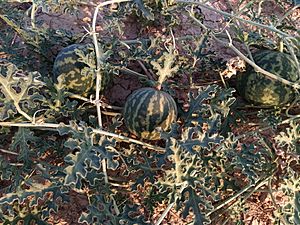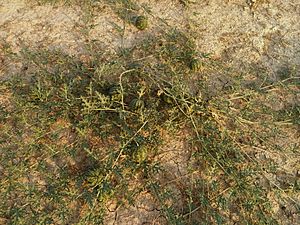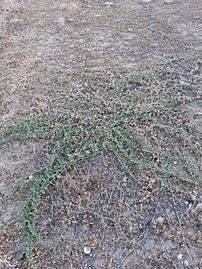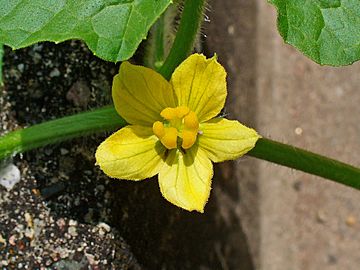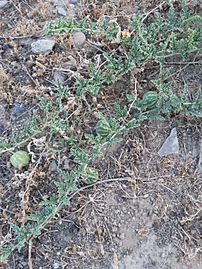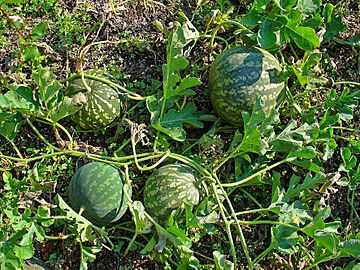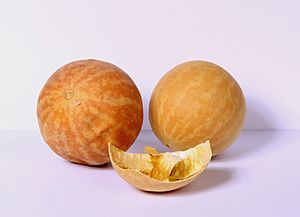Citrullus colocynthis facts for kids
Quick facts for kids Citrullus colocynthis |
|
|---|---|
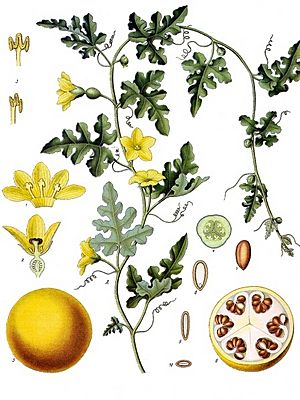 |
|
| Citrullus colocynthis from Koehler's Medicinal-Plants (1887). | |
| Scientific classification | |
| Genus: |
Citrullus
|
| Species: |
colocynthis
|
| Synonyms | |
|
|
Citrullus colocynthis, often called colocynth or bitter apple, is a desert plant that grows like a vine. It's found in areas around the Mediterranean Sea and in Asia, especially in Turkey and Nubia. People also call it names like "bitter cucumber" or "wild gourd."
This plant looks a lot like a regular watermelon vine. However, its fruits are small, hard, and have a very bitter inside. Its original scientific name was Colocynthis citrullus.
Contents
What Does the Colocynth Look Like?
The colocynth vine can grow to be about 2.4 to 3 meters (8 to 10 feet) long.
Roots and Stems
The plant has large, thick roots that live for many years. These roots help the plant survive well, especially because it has a long main root that goes deep into the ground. Its stems spread out in all directions for several meters. They look for things to climb on, like shrubs or other herbs, using small tendrils.
Leaves
The leaves of the colocynth are very similar to those of a watermelon. They are shaped like a hand with three to seven parts.
Flowers
The flowers are yellow and grow alone where the leaves meet the stem. They have yellow-greenish stalks. Each flower has five petals and five sepals (leaf-like parts that protect the bud).
Colocynth plants are monoecious. This means that both male flowers (with stamens) and female flowers (with pistils and an ovary) grow on the same plant. You can tell the female flowers apart because they have a round, hairy ovary at their base.
Fruits
The fruit is smooth and round, about 5 to 10 centimeters (2 to 4 inches) across. It tastes extremely bitter. When the fruit is young, it's yellow-green. As it ripens, it gets yellow stripes, looking like marble. Inside, the fruit has a soft, dry, spongy white pulp. This pulp holds the seeds. Each fruit can have up to 18 seeds. One plant can produce 15 to 30 fruits.
Seeds
The seeds are gray and small, about 5 millimeters (0.2 inches) long. They also taste bitter but have a nutty flavor. They are rich in fat and protein. People can eat them whole or use them to make oil. This oil is useful because it contains healthy fats like linoleic acid and oleic acid. The seeds also have a lot of important amino acids.
Similar Plants
The colocynth looks very similar to the watermelon, which belongs to the same plant group (genus).
Where Does the Colocynth Grow?

Citrullus colocynthis is a desert plant that prefers sandy, dry soils. It is native to the Mediterranean Sea region and Asia. You can find it from the west coast of North Africa, across the Sahara Desert, through Egypt, all the way to India. It also grows in southern European countries and on the islands of Greece. In Cyprus, people grow it on a small scale. It has been a source of income there since the 14th century and is still sold today.
This plant can be either an annual (lives for one year) or a perennial plant (lives for many years) in the wild, especially in dry parts of India. It can survive in very dry conditions. It can handle very little rain (250 to 1500 millimeters per year) and temperatures between 14.8 to 27.8 °C (58.6 to 82 °F). It grows from sea level up to 1500 meters (4,900 feet) high, in sandy soils and along sandy coasts.
How Is Colocynth Grown?
The colocynth is a perennial plant that can grow from both seeds and plant parts (like cuttings). However, seeds don't always sprout well in very dry places. So, growing from plant parts is often more successful in nature.
In the dry areas of India, the plant grows between January and October. The best time for it to grow is during the summer, when it rains more. Its growth slows down when the rain and temperature drop, almost stopping in the cold, dry months of December and January. Colocynth prefers sandy soils and is good at managing water. This makes it interesting for scientists studying how desert plants deal with water shortages. Farmers can add organic fertilizer to help it grow better.
In Nigeria, colocynth is often grown alongside cassava. Like other crops, cultivated colocynth can suffer from weather stress and diseases, such as cucumber mosaic virus. Scientists are working on new ways to grow colocynth that are more resistant to diseases and stress. This helps increase how much fruit the plants produce.
Uses of Colocynth
The colocynth fruit can be eaten or used to make medicine and energy sources like oil and biofuel. Small colocynth seeds have been found at ancient sites in North Africa and the Near East. This suggests that people probably used wild colocynth long before they started farming it.
Traditional Medicine
For hundreds of years, colocynth has been used in traditional medicine.
In Arabia, colocynth was used as a laxative (to help with digestion), a diuretic (to help the body get rid of water), or for insect bites. Sometimes, colocynth powder was put on the skin with other things like aloes or bandages. Small candies or lozenges made from colocynth were used as a laxative.
In traditional Arab animal medicine, the sap from colocynth was used to treat skin problems in camels.
Cooking and Food
The seeds of the colocynth must be separated from the bitter pulp and heated before they can be eaten. For a long time, these seeds have been a food source in parts of the Sahara and Sahel deserts, where other crops often fail. Some desert people, like the Bedouin, are said to make a type of bread from the ground seeds.
The watermelon is a close relative of the colocynth. It was first grown in Ancient Egypt, and it might have been developed from cultivated colocynth for its edible seeds. In West Africa, people sometimes confuse colocynth with watermelon. The name "egusi" can refer to the seeds of either plant, or to a popular soup made from these seeds. The flour made from colocynth seeds is rich in important nutrients. This means it could be used in foods, especially in places like West Africa where people might not get enough of these nutrients.
The flowers of the colocynth can be eaten, and the tips of the stems can provide water.
Other Uses and Research
The oil from colocynth seeds (about 47% of the seed's weight) can be used to make soap. It's not hard to produce this oil because colocynth can grow in poor soils with little water and fertilizer. The fruits are picked by hand before they are fully ripe. The outer skin is peeled off, and the inner pulp with seeds is dried in the sun or in ovens. One hectare of land can produce about 6.7 to 10 tons of seeds, which means up to 3 tons of oil.
Scientists have also found that oils from C. colocynthis can kill mosquito larvae.
Images for kids
-
Colocynths in Adrar Desert (Mauritania)
See also
 In Spanish: Coloquíntida para niños
In Spanish: Coloquíntida para niños


